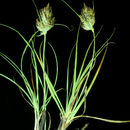Comprehensive Description
provided by North American Flora
Carex douglasii Boott, in Hook. Fl. Bor. Am 2: 213. pi. 214. 1839.
Core;ciVM«aii»JDewey, Am. Jour. Sci.43:92. pl.Cc,f.97. 1842. (Type from Rocky Mountains.) Carex Meekii Dewey, Am. Jour. Sci. II. 24: 48. 1857. (Type from Nebraska Territory.) Carex Douglasii var. densispicata Dewey, Am. Jour. Sci. II. 32: 41. 1861. (Type from Idaho.) Carex Douglasii var. minor 0
ey , in S. Wats, Bot. King's Expl. 363. 1871. (Type from Nebraska.) Carex Fendleriana Bock. Linnaea 39: 135. 1875. (Type from New Mexico.) Carex Douglasii var. laxiflora L. H. Bailey, Mem. Torrey Club 1: 20. 1889. (Type from Utica,
Montana.) Carex irrasa L. H. Bailey, Bot. Gaz. 25: 271. 1898. (Based on C Douglasii var. laxiflora L. H.
Bailey.) Carex Douglasii i. laxiflora "L. H. Bailey" Kukenth. in Engler, Pflanzenreich 4^": 122. 1909. (Based
on C. Douglasii var. laxiflora L. H. Bailey.) Carex Douglasii f. Meekii Kukenth, in Engler, Pflanzenreich 4-°: 122. 1909. (Based on C. Meekii
Dewey.)
Rootstocks long-creeping, slender (1-2 mm. thick), brown with fibrillose scales, the culms 6-30 cm. high, slender but stiff, rather obtusely triangular, smooth, usually exceeding leaves but sometimes shorter, arising 1 to few together, brown at base, and clothed at base with driedup leaves of previous year; leaves with well-developed blades 3-8 to a culm, clustered at the base, the blades erect to spreading, involute above and flattened or canaliculate towards the base, or involute throughout, 5-15 cm. long, 1-2.5 mm. wide, triangular and long-attenuate above, roughened towards apex, thick, light-green, the sheaths tight, truncate and thickened at mouth, the ligule very short; heads usually dioecious, the staminate and pistillate flowers normally on separate culms; staminate heads from oblong-orbicular to linear-oblong, 1.5-4 cm. long, 7-15 mm. thick, the many spikes closely aggregated, but usually readily distinguishable, linear-elliptic, about 8-15 mm. long and 2.5-4 mm. wide, the scales oblong-ovate, acute or short-acuminate, straw-colored or brownish with a broad hyaline margin; filaments slender, exserted, the anthers very conspicuous, elongate-linear, 3.5 mm. long, mucronulate; bracts inconspicuous, the lower short-cuspidate; pistillate heads from suborbicular to oblong, 1.5-5 cm. long, 1-2.5 cm. thick, the many spikes closely aggregated, but usually readily distinguishable, at maturity oblong-elliptic, 5-15 mm. long, 4-8 mm. wide, the scales lanceolate or ovatelanceolate, straw-colored with hyaline margin or often yellowish-brown-tinged, the center 3-nerved, green, acuminate to cuspidate, wider than, exceeding, and covering the perigynia; lowest bract often conspicuous; perigynia closely appressed, plano-convex, ovate-lanceolate, 3.5-4 mm. long, 1.75 mm. wide, straw-colored, at length light-brownish, sharp-edged above, lightly many-striate ventrally, more or less strongly many-striate dorsally, stipitate, round-tapering at base, tapering into a serrulate beak about 1.75 mm. long, obliquely cut dorsally, in age bidentulate, the apex and orifice hyaline; achenes lenticular, obovate, closely enveloped, 1.75 mm. long, 1.25 mm. wide, tapering at base, truncately apiculate, yellowishbrown, shining; style very long, projecting at flowering time, slender, straight, not enlarged at base, jointed with achene; stigmas two, dark-reddish-brown, very long.
Type locality: "Hab. N. W. Coast, Douglas. Rocky Mountains. Drummond." Distribution: Dry, more or less alkaline soil, in open sunny places on the plains, foothills, and lower mountains, from Manitoba to New Mexico, westward to California and British Columbia. Very widely distributed. (Specimens examined from New Mexico, Colorado, Wyoming, Nebraska, South Dakota, North Dakota, Manitoba, Saskatchewan, Alberta. Montana, Idaho, Utah, Nevada, California, Oregon, Washington, British Columbia.)
- bibliographic citation
- Kenneth Kent Mackenzie. 1931. (POALES); CYPERACEAE; CYPEREAE (pars). North American flora. vol 18(1). New York Botanical Garden, New York, NY

